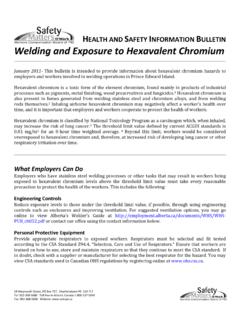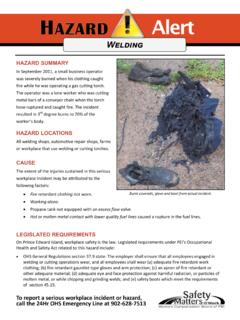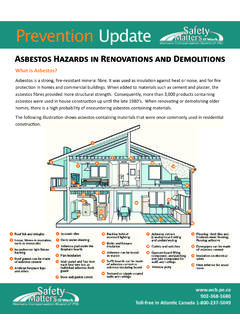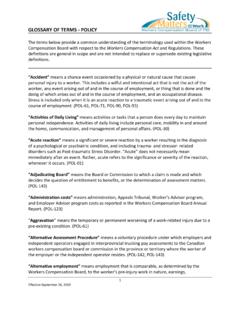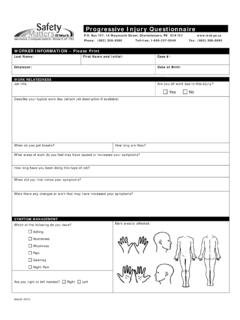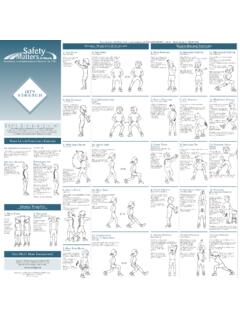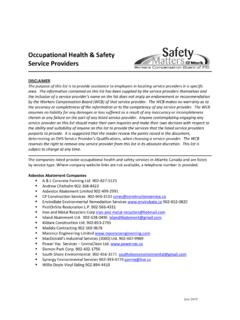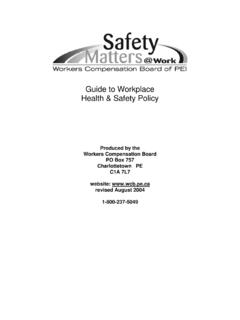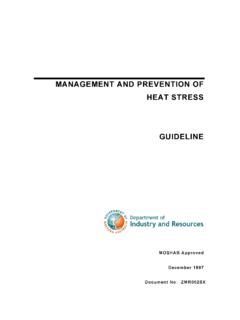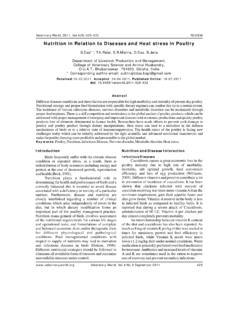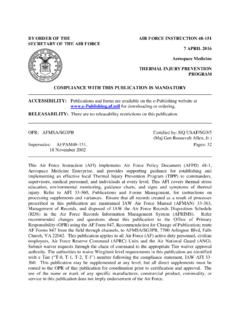Transcription of Guide to Cold Stress at Work - WCB
1 Guide to cold Stress at work WCB Website: free in Atlantic Canada: 1-800-237-5049 Revised: Jan/06 cold Stress at work Working in the cold is part of the job for many Prince Edward Islanders. Workers performing tasks outside in winter or working in cold storage areas can be at risk. cold Stress can occur when the body is exposed to excessive cold or wet conditions. The result can be hypothermia or a lowering of core body temperature. Prolonged exposure of the hands, face or feet to cold can cause is a dangerous condition because it can happen so slowly it is unnoticeable and the victim may not be thinking clearly enough to prevent serious areas where cold Stress is a hazard a plan must be made to ensure workers are properly trained and equipped to prevent injury and treat victims if necessary.
2 Factors Causing cold Stress : xExposure to cold , particularly if the worker is wet, dehydrated or tired. xWind. Wind removes the thin layer of warm air that surrounds the skin. xWater. If clothing becomes wet or damp from water, snow orperspiration the risk is increased. Immersion in cold water willconduct heat away from the body 25 times faster than cold Freezing InjuriesChilblains are a mild injury caused by several hours of exposure to cold foot or trench foot is caused by prolonged exposure to wet conditions. These conditions can develop after an average of three days of the feet being wet and exposed to temperatures between 0 and 16 degrees Celsius.
3 The hands can also be affected under similar conditions. Symptoms include tingling, numbness, itching, swelling and pain. The feet or hands may start red and turn InjuriesFrost nip occurs when the top layers of skin are frozen after exposure to the is treated by slow, gentle warming. Hot objects should not be used. The skin should not be bite happens when tissue temperature falls below freezing or when blood flow is obstructed. In mild cases there is skin inflammation and some pain. In severe cases the tissue damage can be painless but become infected can result in serious injury.
4 First Aid should include prevention of further cold exposure but should not include rubbing or heat . Take the victim for medical to Reduce the Risk of cold Stress Cover your head. 50% of heat can be lost through the head. Wear layered clothing. Layers trap warm air and help to retain heat . The first layer should be thin and help to keep moisture away from the body. Polypropylene is a good choice. Wool is a good second layer because it stays warm even if it gets wet. Cotton tends to absorb water making it less effective. Keep your clothing loose so it does not compress under layers and keeps the layers of warm air intact.
5 Make the outer layer wind and water proof. Pace yourself if you have physically demanding work to do. Fatigue will contribute to hypothermia. To stay dry reduce perspiration by removing layers or loosening the neck, wrists and waist of clothing. Protect your hands and feet. Use mittens rather than gloves where possible. Carry extra pairs of felt liners and mittens if they may get wet. Keep skin dry. Set up shelters to block wind where possible. Schedule work to be done on warmer days or during the warmest part of the day where possible. Take breaks in a heated building and increase the frequency of breaks where the cold or wind is more intense.
6 Be sure to remove outer layers while you are in the warmer environment. Drink plenty of warm fluids. Good hydration helps circulation. Caffeinated beverages and alcohol are not a good idea because they cause more blood flow to the surface of the skin. This can expose the blood to more cold and result in a decrease in core body temperature. Cover metal handles and bars with an insulating material. Use tools and machines that can be operated with mittens. Monitor the temperature and wind and adjust work and breaks accordingly. Educate workers about the signs and symptoms of hypothermia as well as its prevention.
7 Set up a buddy system to monitor early signs. In very cold weather or windy conditions consult the guidelines under Extreme Hot or cold Temperature on the Canadian Centre for Occupational Health and Safety WEB site at; ( ) These guidelines suggest a work / break schedule for specific wind chill and Symptoms of Hypothermia Mild Hypothermia: The first signs are bouts of shivering, severe shivering, poor judgment, confusion and can show up several hours after exposure to the cold . Hyperthermia should be treated quickly because it is hard to know how severe it is or how long it has been developing.
8 Moderate hypothermia causes confusion, difficulty thinking and poor co-ordination so the victim may not be able to follow instructions. Breathing may become shallow and the pulse may be slow or weak. The victim may stop shivering. Severe hypothermia : Shivering stops. Although the victim will be unable to perform tasks he or she may be able to stand and appear alert. cold slows down the body functions so the victim may survive for hours with no obvious signs of life. Severe hypothermia should always be treated as a medical emergency even in the absence of detectable heart rate or for Hypothermia Victims If moderate or severe hypothermia is suspected treat as a medical emergency and call 911.
9 Move the victim to a warm, dry environment. Remove wet clothing and replace it with warm dry layers. Make sure the head is covered and the layers underneath are warm and dry. Get medical help. Remember one of the first symptoms is confusion so the victim may deny problems. Train all workers in signs, symptoms and initial treatment. Allow the victim to shiver because it creates body heat . Handle the victim gently and minimize exertion. In moderate or severe hypothermia rough handling can cause irregularities in the heart beat and death. Do not massage extremities Do not make the victim exercise Do not place the victim in a warm bath or shower.
10 In cases of moderate and severe hypothermia the victim may have changes in their level of consciousness, breathing and heart rate. Do not initiate CPR unless you have not found a pulse for over a is dangerous to start and stop CPR on a hypothermia victim so if you must start do not stop. Continue first aid treatment even if the victim appears lifeless. They may survive a long time at cold Regarding cold Hazards On Prince Edward Island, the Occupational Health and Safety Act, Regulation # Extremes of Temperature, requires that permissible heat and cold exposure shall conform to Threshold Limit Values (TLV s) published by the American Conference of Governmental Industrial Hygienists.
